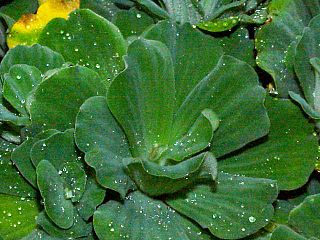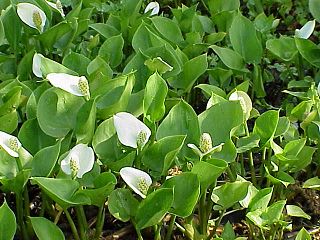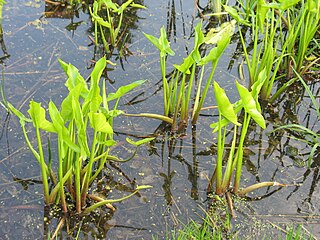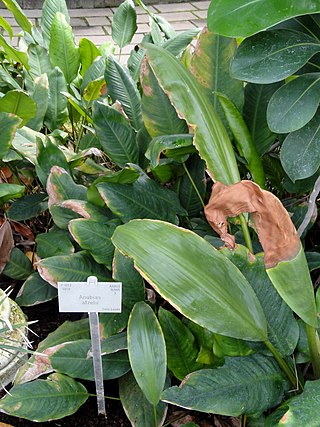
The Araceae are a family of monocotyledonous flowering plants in which flowers are borne on a type of inflorescence called a spadix. The spadix is usually accompanied by, and sometimes partially enclosed in, a spathe. Also known as the arum family, members are often colloquially known as aroids. This family of 140 genera and about 4,075 known species is most diverse in the New World tropics, although also distributed in the Old World tropics and northern temperate regions.

Acorus is a genus of monocot flowering plants. This genus was once placed within the family Araceae (aroids), but more recent classifications place it in its own family Acoraceae and order Acorales, of which it is the sole genus of the oldest surviving line of monocots. Some older studies indicated that it was placed in a lineage, that also includes aroids (Araceae), Tofieldiaceae, and several families of aquatic monocots. However, modern phylogenetic studies demonstrate that Acorus is sister to all other monocots. Common names include calamus and sweet flag.

Pistia is a genus of aquatic plants in the arum family, Araceae. It is the sole genus in the tribe Pistieae which reflects its systematic isolation within the family. The single species it comprises, Pistia stratiotes, is often called water cabbage, water lettuce, Nile cabbage, or shellflower. Its native distribution is uncertain but is probably pantropical; it was first discovered from the Nile near Lake Victoria in Africa. It is now present, either naturally or through human introduction, in nearly all tropical and subtropical fresh waterways and is considered an invasive species as well as a mosquito breeding habitat. The genus name is derived from the Greek word πιστός (pistos), meaning "water," and refers to the aquatic nature of the plants. The specific epithet is also derived from a Greek word, στρατιώτης, meaning "soldier," which references the sword-shaped leaves of some plants in the Stratiotes genus.

Caladium is a genus of flowering plants in the family Araceae. They are often known by the common name elephant ear, heart of Jesus, and angel wings. There are over 1000 named cultivars of Caladium bicolor from the original South American plant.

Anubias is a genus of aquatic and semi-aquatic flowering plants in the family Araceae, native to tropical central and western Africa. They primarily grow in rivers and streams, but can also be found in marshes. They are characterized by broad, thick, dark leaves that come in many different forms. The genus was revised in 1979 and since then its nomenclature has been stable. Species can be determined by using mostly characteristics of the inflorescence. Because of the often shady places where the plants grow, the genus was named after the Egyptian god Anubis, the god of the afterlife. The genus was first described in 1857 by Heinrich Wilhelm Schott, with A. afzelii as its type species.

Zamioculcas is a genus of flowering plants in the family Araceae, containing the single species Zamioculcas zamiifolia. It is a tropical herbaceous perennial plant, native to eastern Africa including Kenya, KwaZulu-Natal, Malawi, Mozambique,Tanzania, and Zimbabwe. Common names include Zanzibar gem, ZZ plant, Zuzu plant, aroid palm, eternity plant and emerald palm. It is grown as a houseplant mainly for its attractive glossy foliage and easy care. Zamioculcas zamiifolia is winter hardy to USDA Zones 9–10.

Calla is a genus of flowering plant in the family Araceae, containing the single species Calla palustris.

A leaf miner is any one of numerous species of insects in which the larval stage lives in, and eats, the leaf tissue of plants. The vast majority of leaf-mining insects are moths (Lepidoptera), sawflies, and flies (Diptera). Some beetles also exhibit this behavior.

Arisaema dracontium, the dragon-root or green dragon, is a herbaceous perennial plant in the genus Arisaema and the family Araceae. It is native to North America from Quebec through Minnesota south through Florida and Texas, where it is found growing in damp woods. It has also been reported from northeastern Mexico Plants grow 20–50 centimetres (7.9–19.7 in) tall when in bloom and after flowering reach 100 centimetres (39 in), and each grows from a corm. Normally, a plant produces one leaf with a long petiole, its leaf is composed of 7 to 13 leaflets, with its central leaflet being the largest one and with leaflets becoming smaller as they are produced distally, the leaflets are held out horizontally over the plant. During flowering in spring, a single slender, green spathe 3–6 centimetres (1.2–2.4 in) long is produced; it covers a tapering, long thin spadix. The tail-like spadix grows out around the top of its spathe. After flowering, up to 150 berries are produced in a club-shaped column. In late summer, the green berries turn orange-red, each berry produces 1 to 3 seeds. It is listed as a vulnerable species in Canada.

Cryptocoryne beckettii, also known as Beckett's water trumpet, is a plant species belonging to the Araceae genus Cryptocoryne.

Thaumatophyllum bipinnatifidum is a plant in the genus Thaumatophyllum, in the family Araceae. Previously it was classified in the genus Philodendron within subgenus Meconostigma. The commonly used names Philodendron bipinnatifidum and Philodendron selloanum are synonyms. This plant is native to South America, namely to Brazil, Bolivia, Argentina, and Paraguay, but is also cultivated as a landscape plant in tropical, subtropical and warm temperate climates.

Peltandra virginica is a plant of the arum family known as green arrow arum and tuckahoe. It is widely distributed in wetlands in the eastern United States, as well as in Quebec, Ontario, and Cuba. It is common in central Florida including the Everglades and along the Gulf Coast. Its rhizomes are tolerant to low oxygen levels found in wetland soils. It can be found elsewhere in North America as an introduced species and often an invasive plant.

Anubias afzelii is a species belonging to the Aroid genus Anubias. It was first described scientifically by Heinrich Wilhelm Schott in 1857, based on material collected in Sierra Leone by Adam Afzelius, after whom the species was named. The genus Anubias was described simultaneously, with only A. afzellii belonging to it, which therefore is the type species of the genus. No other species currently placed in the genus Anubias was described earlier and A. afzelii was therefore the first species of this genus known to science.

Lemnoideae is a subfamily of flowering aquatic plants, known as duckweeds, water lentils, or water lenses. They float on or just beneath the surface of still or slow-moving bodies of fresh water and wetlands. Also known as bayroot, they arose from within the arum or aroid family (Araceae), so often are classified as the subfamily Lemnoideae within the family Araceae. Other classifications, particularly those created prior to the end of the twentieth century, place them as a separate family, Lemnaceae.

Anubias gigantea is an aquatic to riparian aroid species belonging to the genus Anubias, within the Araceae. It was first mentioned by Auguste Chevalier in 1920, based on material that he had collected in Guinea, West Africa. The formal description followed in 1939 by John Hutchinson. It is closely related to A. afzelii, basically only differing from that species by the form of the leaf-blade, with mature growth appearing somewhat different than the juvenile plants.
Orontium mackii is an extinct golden club species in the family Araceae described from a series of isolated fossil leaves. The species is known from Late Cretaceous sediments exposed in the state of New Mexico in the United States of America. It is one of several extinct species placed in the living golden-club genus Orontium.

Anubias hastifolia is a species belonging to the Aroid genus Anubias. It was first mentioned by Adolf Engler in 1889 and described scientifically by him in 1893.

Warnstorfia exannulata is a leafy branching wetland moss in the genus Warnstorfia within the family Amblystegiaceae and class Bryopsida. This bryopsida moss is also known as ringless-hook moss or Warnstorfia moss. It is the most common species of the genus in wetland environments and can be difficult to distinguish from others within the genus. It grows in acidic soils like fens and bogs, or in freshwater pools and lakes.
Monstera subpinnata is a species of flowering plant native to Bolivia, Peru, Ecuador and Colombia. It grows as an epiphyte. The plant is best known for its pinnate leaves, which are unusual within the genus Monstera. The species can grow as tall as 12 m, with leaves growing as large as 40 cm long and 30 cm wide.
Xanthosoma paradoxum is a species of flowering plant in the family Araceae indigenous to Colombia. Initially described as Caladium paradoxum, it was later transferred to the Xanthosoma genus due to its strong affinity with other Xanthosoma species.

















